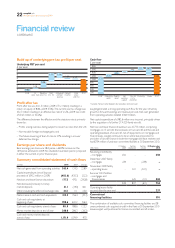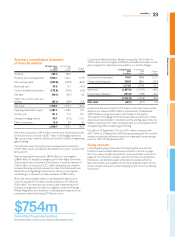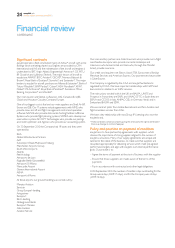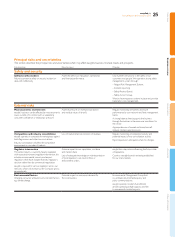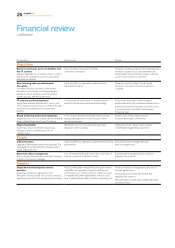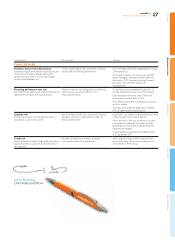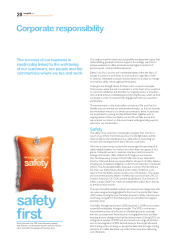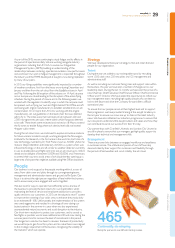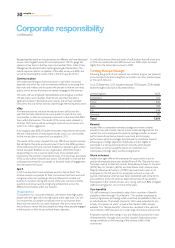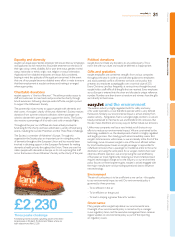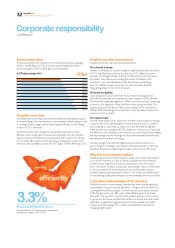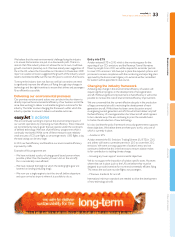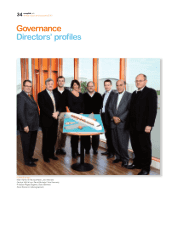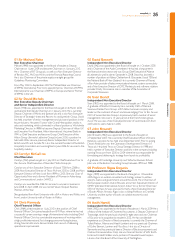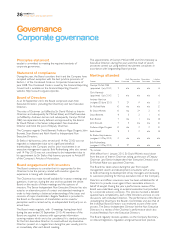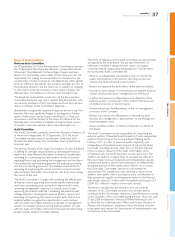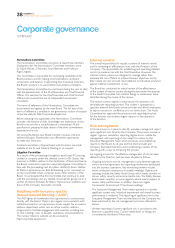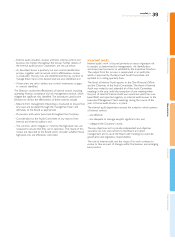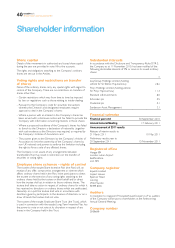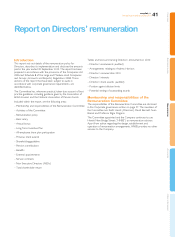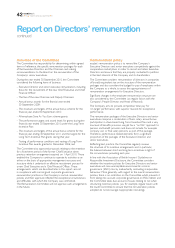EasyJet 2010 Annual Report Download - page 34
Download and view the complete annual report
Please find page 34 of the 2010 EasyJet annual report below. You can navigate through the pages in the report by either clicking on the pages listed below, or by using the keyword search tool below to find specific information within the annual report.
Corporate responsibility
continued
Environment data
In total we emitted 4.51 tonnes of CO2 in the year and per passenger
trip this was 96.9kg. Our CO2 emissions per passenger kilometre
decreased again in 2010 to 84.4 grams per kilometre.
Progress over time
We believe the most important environmental issue facing the industry
isclimate change. We have focused on ensuring the industry plays its role
in tackling climate change and on improving the efciency of our ying
interms of CO2 emissions.
Over the last ten years, easyJet has successfully improved its CO2
efciency every single year. Emissions per passenger km (the standard
industry measure of efciency) has improved every year, from 116.2 g/
km in 2000 to 83.1 g/km in 2010. We have continued to reduce CO2
emissions per passenger journey, from 97.7 kg in 2009 to 96.9 kg in 2010.
Aviation and the environment
Aviation has three main environmental impacts:
On climate change
Aviation contributes to climate change through both the direct emission
of CO2 from fuel burn and due to other non-CO2 effects from the
emission of Nitrogen Oxides (NOx), particles and aerosols and cloud
formation. The science surrounding the impact of aviation’s CO2
emissions is very well developed, while the science surrounding
non-CO2 effects remains uncertain. It is clear, however, that the
long-lasting impact is from CO2 emissions.
On local air quality
Local air quality impacts arise from NOx emissions during aircraft
take-offs and landings. We operate the latest standard CFM (with the
Tech Insertion upgrade) engines on 40% or our eet, and are continuing
to invest in this upgrade so that it will be in place across the eet. This
reduces emissions (by about 1%) but also reduces NOx emissions by
20% to 30%. These engines are the best in class and help minimise our
impact on local air quality.
On noise levels
Aircraft noise clearly has an impact on residents around airports. easyJet
complies with local rules that govern noise at airports (such as curfews
and routeings to avoid built up areas). Our aircraft meet the tightest
international noise standards (ICAO chapter 4). Our focus on improving
the efciency of our ying has also reduced our noise impact; by changing
the ap settings used for landings we have both improved fuel efciency
and reduced noise levels at landing.
Climate change is the dominant global environmental issue and it is
alsoof long-term strategic importance to the airline industry. We have
therefore focused our reporting and public policy work on this issue.
Why the environment matters
Addressing our environmental impact is clearly part of our responsibility
as an airline. However, it is also a business imperative. Environmental
concerns have a signicant impact on public policy towards aviation,
fromrestrictions on airport expansion to passenger taxes. It is therefore
in our own interest to ensure that both we and the wider industry
properly address environmental concerns. This is why we have focused
on considering public policy solutions to the challenges the industry faces.
Long-term sustainability of the industry
Aviation emissions have increased steadily over time, despite signicant
improvement in environmental efciency – the growth in air trafc has
outweighed the efciency gains. Over the last ten years, global aviation
trafc has grown by over 5% a year, while efciency gains have been
about 2%. This has led to concerns that aviation emissions will continue
to grow into the future and that this will be inconsistent with the overall
reductions in greenhouse gas emissions that are needed to limit the
impact of climate change. This is clearly unsustainable and needs to
change going forward.
Environmental efficiency
We improved our CO2 emissions per passenger
kilometre by a further 3.3% in 2010.
3.3%
84.40
90.31
95.56
87.30
95.70
104.50
110.00
98.80
106.90
112.50
116.20
g CO2/passenger Km
–2.9
ppt
2010
2008
2007
2009
2006
2004
2003
2005
2002
2001
2000
32 easyJet plc
Annual report and accounts 2010


